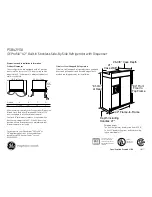
8 Tips and tricks
8
Tips and tricks
8.1
General information on using the appliance
▪
When closing an appliance door make sure that it forms a proper seal all the way
round.
▪
It can take several hours for food and beverages to cool down from room temperature
to the temperature of the refrigerator compartment.
▪
Opening the door for long periods can cause a significant increase of the temperature
in the refrigerating zones of the appliance.
▪
Make sure that food or food items on the glass shelves do not tip over when the appli-
ance door is closed or prevent it from closing properly.
▪
Surfaces that can come in contact with food and accessible drainage systems must
be cleaned regularly.
▪
Changing the temperature setting has no effect on the cooling rate. The fast cooling/
freezing functions increase the cooling rate.
▪
Placing very warm or very cold items (e.g. warm, bottled sauces or frozen food for de-
frosting) directly in front of a temperature sensor (integrated in the right-hand side wall
of the upper section of the refrigerator compartment and above the top drawer of the
freezer compartment) can affect the temperature regulation of the refrigerating appli-
ance adversely: it may cool too little or too much.
▪
Ensure that the air outlets are not blocked by food items.
8.2
Notes on refrigerating and freezing food
▪
Activate the
fast cooling/freezing function before putting the food or food items in
the appliance (e.g. before going shopping).
▪
High-protein and high-fat foods are delicate/perishable and have a relatively short
storage life.
▪
Observe best-before and use-by dates.
▪
Wrap or cover food in the refrigerator compartment to prevent it from drying out and
flavours from transferring.
▪
Transfer the contents of opened tins to sealable containers.
▪
Store raw meat and fish in suitable containers in the refrigerator, so that it is not in
contact with or drip onto other food.
▪
There is a risk that freezing fresh food could cause food that is already frozen to par-
tially thaw. Freeze smaller quantities and avoid contact with food that has already
been frozen.
▪
Depending on the product, the following packaging materials are suitable: freezer
bags, aluminium foil or plastic boxes. Freezer burn can be avoided by making the
food packaging as airtight as possible.
▪
Do not refreeze food once defrosted! Only after being prepared (through cooking or
frying) can food be refrozen.
▪
Blanch vegetables before freezing. Aubergines, sweet peppers, courgettes, mush-
rooms, asparagus and herbs do not have to be blanched.
▪
The following products are not suitable for freezing: radishes, lettuces, cucumbers,
raw unshelled eggs, boiled eggs, dairy products such as yogurt, cream cheese, curd
cheese and mayonnaise.
29












































